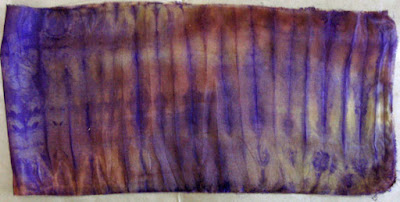Although I began my dyeing career with acid dyes, I didn't really do much shibori until after I started dyeing with fiber reactive dyes.
I have a student coming in January for a weekend shibori & dye painting intensive, working with both cellulose and protein fibers. Meaning I'll be teaching shibori and dye painting techniques for both fiber reactive and acid dyes. It'll be a whirlwind weekend but I've got it mapped out so she can learn the basics for both types of dye.
Anywho, yesterday and today I did acid shibori dyeing using techniques I learned for fiber reactive dyes, translated for use with acid dyes. These are some of my results. I used a 2-yard piece of light weight habotai silk torn into eight pieces. The first 3 images are from yesterday's immersion bath. The top image was folded and put right in the dyebath.
The 2nd and 3rd images had been underpainted the day before. Underpainting is something I learned a couple years ago although I haven't done it very much. The idea is to prepaint the fabric the day before, let it dry, then overdye it in the immersion bath. The immersion bath had citric acid and salt added along with the dye. If you were doing this process with fiber reactive dyes, you'd add soda ash to the bath instead of citric acid. The underdye had not been set prior to being prepared for shibori and immersed in the pot. I brought the pot up to 185 degrees and let it steep for an hour, then left everything in the pot until the liquid was cool.
The last 2 images were dyed this morning -- actually, the one just above had also been underpainted earlier this week. Today I dipped each piece of fabric in 50/50 vinegar water, then folded, bound, whatever, and put each piece in a plastic baggie. I squirted dyes on the fabric and did my best to get the dye distributed. The baggies were steamed for 30 minutes. This technique is another one commonly used for fiber reactive dyes and cellulose fabrics.
These were process experiments only. The dyes I used had been sitting in jars, already mixed, for probably 3 years.
So my suspicion was correct ~ you can do exactly the same types of shibori processing with acid dyes as with fiber reactive dyes. That's what I wanted to know.
Don't forget the giveaway happening now -- see this post for details. Winner to be drawn January 3.
skip to main |
skip to sidebar
Top Articles
Recommended Sites
Popular Posts
-
Hi everyone I hope you are all well and happy. Its that time again, time for me to create something using printables designed by our lovely ...
-
Made another batch of Stampheads on Saturday. Some of the background images are from vintage magazines, and some from contemporary mags. I ...
-
I've used the Ephemera Sampler #2 - Motherly Love , a mix sampler of ephemera, sentiments, tags and other little bits that can make you...
-
Art Journal page, March 2014, 9 x 9 inches Earlier this week I had the startling realization that I've been subtly stressing myself out ...
-
Hello Crafty Peeps... The weekend is here!!! Today I have a gift card holder and tag I did using the GORGEOUSdesigns from the Monochrome Jou...
-
Alright, I finished 9 pairs of this style, which I used to call "Babies," because they were such cute little babies. The group sh...
-
Hello Everyone.... Marleen here with another lovely card for you!!! For this card I used a sketch. Its not something I have ever done muc...
-
Sample purple group, 11 x 14" collages My collage practice/operation has changed a lot over the years since I began it in 2008. I'...
-
Later this week I'll be moving my "everyday journaling" into this new journal, Creative Days. I made this last August in the ...
-
I needed some birthday cards to send to friends. Was in a sewing mood the other day. So I made these. Paper machine stitched on blank not...
Blog Archive
-
▼
2011
(300)
-
▼
December
(32)
- When One Door Closes...
- 12.30.2011
- 12.29.2011
- Acid Dye Shibori
- 12.28.2011
- A Glittering New Year
- 12.26.2011
- Return of the Light
- 12.23.2011
- 12.22.2011
- 12.21.2011
- 12.20.2011
- 12.19.2011
- Giving It All Away
- 12.17.2011
- Pot's Worth
- 12.16.2011
- 12.15.2011
- Fabulous Perfect Last Minute Gift Idea♥
- 12.14.2011
- 12.13.2011
- 12.12.2011
- Cycles of Time
- 12.09.2011
- 12.08.2011
- 12.07.2011
- 12.06.2011
- Stitchin' Fool
- 12.05.2011
- 12.03.2011
- 12.02.2011
- 12.01.2011
-
▼
December
(32)
Copyright © 2013. Design Rose













0 comments:
Post a Comment